Strategy Game: The Navy SEALs
|
|
In 1998 a major publisher asked me to write up a one pager on a Navy SEALS strategy-action game. This type of game began with titles like “Spec Ops” and “Navy SEALS” and was catapulted into the megahits like Tom Clancy’s Rainbow Six and its subsequent titles like Ghost Recon and Rogue Spear.
Let’s first research the subject Navy SEALs and analyze the current titles that have already preceded us.
History and Facts
In 1962 President John F. Kennedy shared his vision of a special forces military that would combat unconventional warfare, counter-guerilla warfare, and clandestine operations in maritime and riverine environments.
SEAL stands for SEa-Air-Land. SEAL teams receive the SEAL mission and carry out their orders through amphibious support. SEALs must be U.S. male citizens, 28 years or younger. SEALs must have good eyesight with no color blindness.
The physical test screening consists of swimming 500 yards using a breast or sidestroke in under 12.5 minutes, 42 push-ups in two minutes, 50 sit-ups in two minutes, six pull-ups, and a 1.5-mile run wearing boots and long pants in under 11.5 minutes.
SEAL Platoon
A SEAL platoon consists of 8 to 16 members, including two officers, one chief, and 5 to 13 enlisted men such as a point man, a patrol leader, a radioman, 60 gunners, and a rear security man.
The West Coast SEAL teams are responsible for the Pacific Rim, Far East, and Africa/Middle East. The East Coast SEAL teams are responsible for South and Central America, Europe, Russia, and the Mediterranean/Eastern Block territories.
The commander is of rank lieutenant or higher and is in communication with the Task Unit Headquarters with his PRC 117, which his radioman is equipped with, and an MX-300 UHF to instruct his snipers and shooters. The commander patrols as the leader and trails the initial chaos of entry to better control the platoon.
The assault force commander wears a helmet/radio headset, a SPIE rig harness hookup, Nomex gloves, a UDT life jacket, a sit harness, and a Nomex flight suit. He also carries an MP-5 (primary weapon), a secondary weapon (a pistol), flash crashes in a pouch, tie ties for prisoner handling, an UHF MX300-R hand-held radio, medical IV, a one-quart water bottle, a gunshot kit, a gas mask, and grenade inside the grenade pouch.
The breacher is responsible for forced entry into a closed area by utilizing explosives (“breaching charges”) that accurately blast objects forward, away from the assault team. He can also use his sledgehammer to break down doors and walls and is an expert at picking locks if a stealth entry is needed. They train in specialized courses like applied explosive technology and SEAL weapons systems. The breacher wears a helmet, body armor, a Nomex flight suit, Nomex gloves, SPIE rig hookup, a UDT life jacket, and a sit harness. He carries a Remington 870 12-gauge shotgun (primary weapon), spare magazines of ammo, a secondary weapon, a crow bar, a mag light, a sledgehammer, SPIE rigging, a one-quart water bottle, flash crash grenades, a gas mask, MK-13 flares, and a gunshot medical kit and IV.
The sniper is a skilled assassin utilizing deadly skills and camouflage outfits. Snipers rely on real-time intelligence data from the commander. Some missions have the snipers precede the assault team by several days and perform special reconnaissance for the team from a hidden position. When instructed by their commander, the snipers will initiate the assault by removing any guards or terrorists and cover the assault team’s entry into the target area. The snipers are a valuable asset of the assault team. The assault force sniper wears a helmet/radio headset, SPIE rig hookup, body armor, a sit harness, and a Nomex flight suit. He carries an M-16 (primary weapon) with an Aimpoint 3000 optical sight, a .45-caliber handgun (secondary weapon), 40mm grenade vest fully loaded, a UHF MX300-R hand-held radio, and a gunshot kit.
Platoon Loadout (Uniforms)
The standard desert operator loadout is for the members to adapt to the world’s most cruel environment, the desert. Each member wears desert camouflage fatigues, and has a long range M-14 (primary weapon), tinted eye protection, dust goggles, sat-com radio (UHF MX300-R radio), GPS (global positioning system), a radio headset, night vision devices, desert camo bush cap, precision timepiece, two-quart canteen, K-Bar survival knife, an ammo pouch filled, a secondary weapon (a pistol), and a camelback hydration system with an access tube.
The winter warfare loadout consists of their normal loadout plus three lines of gear. The first line of gear includes survival gear such as a compass, flashlight, map, signaling device, emergency rations, spare parts, E & E kit (Evasion and Escape), and a side arm (pistol). The second line of gear includes equipment such as the primary weapon, ammo, grenades, water, medical kit, smokes, flares, and caribiners. The third line of gear includes the equipment stored in the rucksack, such as the sleeping bag, ground pad, tent, mission’s food, gas stove, utensils, dry socks, extra layers of clothing, and a water container. If needed, mountain gear such as an ice pick and snowshoes will also be added to the rucksack.
SEAL Weapons
A Colt .45 is a handgun with an immense amount of power for its size. The Colt .45 large caliber has a force that will stop any aggressive assailant (a huge advantage, especially in trenches). Many SEALs still prefer the Colt .45 over the new P226.
Another SEAL handgun, the P9, is a 9mm automatic that utilizes the H7K roller-delayed blowback technology. The P9 is an inch shorter than the Colt .45 and half a pound lighter.
The M16 and M203 assault rifles have 40mm grenade launchers. The M203 can be attached to the barrel and foregrip of the M14, M16, and Colt 727.
The MP5 compact submachine gun can shoot 9mm rounds at 800 rounds per minute. The gun uses the unique roller-delayed blowback technology, which allows the gun to fire in a fully locked breach position. The MP5 chamber is sealed off by a series of locks and cams, which gives the shooter accuracy when the first round is fired and can mean the difference between success and failure. The MP5 can fire a single shot, a three-round burst, or a full automatic at 800 rounds per minute.
The M60 is a tripod-mounted weapon weighing 23 pounds and using 7.62mm caliber ammunition. Normally, the M60 is a three-person operating weapon, but SEALs operate it as a one-man weapon. A SEAL platoon may have two to three members carrying an M60 so opposing forces may think the SEAL platoon has more members than it really has.
SEAL Vehicles
A desert HumVee is a new SEAL workhorse desert terrain vehicle.
A desert patrol vehicle (fast attack vehicle) is good for long-range reconnaissance and rescue missions. It has no armament and is vulnerable to attack. The DPV can travel fast, is very agile, and can traverse any terrain.
A rigid inflatable boat (RIB) is an extremely fast inflatable boat with a solid hull. The RIB comes in two sizes: the 24-foot and the 30-foot high buoyancy extreme weather craft. The 30-foot craft can get close to the beach if the SEAL platoon is under fire due to its water jet propulsion system.
The Mark V is an 82-foot craft propelled by two 2,285 horsepower HP MTU 12V386 TE94 engines with two KaMeWa K505 water jets. The craft holds 2,600 gallons of fuel and can cruise at speeds between 25 and 45 knots (with a top speed of 50 knots). It can hold a payload of 6,400 pounds and has a range of over 500 nautical miles.
SEAL Training
Land warfare training begins with small tactical unit basics to full mission profiles training in a simulated combat scenario. The platoon will practice shooting for hours on end using .556, .762, and 9mm rounds. Immediate action drills (IADs) are fire and maneuver drills through live fire, day and evening practices, with pop-up flares, smoke bombs, “practice” drop-off charges, and incoming rounds of ammo. This training is followed by a week of field training exercises where the platoon is semi-isolated in a simulated combat scenario. During this week, they will practice special reconnaissance, standoff weapons direct action raid, body snatch, point ambush, and combat search and rescue. The training may include a desert patrol vehicle or a helicopter assist.
In Puerto Rico, hydrographic (water) reconnaissance includes underwater demolition of submerged obstacles, a combat swimming course, and three weeks of diving. A full mission profile consists of being dropped off by a sea vessel or an aircraft for a 30-mile “over the horizon” swim, followed by a turtleback (full dive gear surface kicking toward a dive point), a four-hour, multi-leg dive into an enemy harbor to set limpet mines on the hulls of the target ships, and then evading the anti-swimmer measures designed by the training staff.
Puerto Rico also hosts the jungle warfare training along with Panama. Missions through the dense jungle are practiced using a pump shotgun to clear the dense foliage. Thousand-yard patrols are done, which can take several hours as the path is cleared and the extreme humidity has sweat dripping down your back. Setting up jungle hammocks is required and practiced. The jungle training simulates the SEAL teams in a Vietnam scenario as well as SEAL Team Four’s territories in South and Central America fighting the drug war.
SEAL Teams Two and Five operate in cold, snowy regions. In Alaska, Montana, Upstate New York, and Norway the extreme cold weather/winter training is conducted. This training includes cross-country skiing, snowshoeing, winter and mountain warfare tactics, survival, escape, and evasion techniques. Drills using the combat rubber raiding craft (CRRC) are conducted over 60 miles of open ocean.
Entering and exiting a moving submarine is practiced (also called submarine lock out/lock in). Exiting and entering the submarine through a dry dock shelter is also practiced (DDS MSLO/LI or dry dock shelter mass swimmer lock out/lock in).
Close quarter battle (CQB) requires extensive training, fast recognition, and good reflexes. Some CQB situations include taking down a house one room at a time, hostage rescue in a bus, train, or airplane, and securing a ship after boarding it by air or sea. Advanced courses in explosive entry methods (like blowing open a door without injuring the platoon), room entry techniques (firing your CAR-15 or MP-5 submachine gun), and blinding techniques (using flash bangs) are part of the SEAL training. The ability to properly identify the hostages and the terrorists in a split second in a terrorist/hostage situation is practiced for many hours.
Special missions called VBSS (visit, board, search, and seizure) are critical skills since these missions have the entire platoon securing and controlling a ship.
Special mission training includes unconventional warfare (UW) simulated behind the guerrilla lines scenario, foreign internal defense (FID) training foreigners during peacetime, direct action (DA) where a potential use of force is warranted (ambushes, hostage rescue, target assaults), counter terrorist (CT), and special reconnaissance (SR) where information gathering is done.
SEALs train in parachute rigging, sniper school, emergency medical technician, weapon’s repair, target analysis, intelligence photography, stinger weapon school, hand to hand combat fighting course, NSW communications school, applied explosive techniques, and freefall school and jumpmaster training.
Break Time
At this point we have learned a lot about the Navy SEAL team and platoon responsibilities.
Lots of gaming ideas and concepts should be circling your brain. One idea is a SEAL team game with several missions, such as a hostage rescue in a Middle East town like Beirut, Lebanon, a VBSS mission to seize and control a ship, and a mission to neutralize a South American drug operation.
Perhaps SEAL training is the design you want to begin with, which could lead to several choice missions utilizing the skills learned. There are so many different design concepts that can arise from just a few pages of information about Navy SEALs that a day ago you might not have known. Research helps solidify your initial vision and puts real life situations and facts into your design. Players require a believable storyline and realistic gameplay.
Multiplayer games of this nature have several types of play: deathmatch, capture the flag (CTF), cooperative, and king of the hill (KOTH).
In deathmatch, all players compete against each other to eliminate the most opponents. In capture the flag, players must seek out and capture the opposing side’s team flag and return the flag to their own home base to win. In cooperative play, all players control one of the single player’s squad mates. In king of the hill, the player who occupies a specific marked area for the longest cumulative time wins the game.
Navy SEAL Games
Let’s look at several existing games that are based on the Navy SEAL concept. I have chosen several top games including Electronic Arts’ SEAL Team, Zombie Interactive’s Spec Ops, Yosemite Entertainment’s Navy SEALs, Novalogic’s Delta Force, Delta Force 2, Delta Force Land Warrior and their sequels, and Red Storm’s Rainbow Six, Rogue Spear, and Ghost Recon and their sequels.
Electronic Arts’ SEAL Team, 1993 IBM PC-DOS
This is a 3D tactical combat simulator of the Navy Special Operations in the Mae Khong Delta, Vietnam. Missions include espionage, rescue, recon, and demolition scenarios. Players can choose their team from dozens of commandos who each have their own statistics and specialty. An important gameplay concept is to select many new commandos for each mission, giving them all vital experience. The key to winning SEAL Team is patience and good observation skills.

Good: Team coordination and authentic hand signals used for tactical operations is well done.
Bad: Underwhelming graphics and long pauses waiting for realistic action to occur really hurt this game.
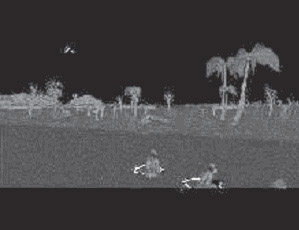
Zombie Interactive’s SPEC OPS, 1998 IBM PC
Spec Ops had a few versions, such as SPEC OPS: Rangers Lead the Way, SPEC OPS: Ranger Team Bravo, SPEC OPS: Stealth Patrol, SPEC OPS 2, SPEC OPS: Omega Squad, and SPEC OPS: Ranger Elite.
SPEC OPS: Ranger
SPEC OPS: Ranger was one of the first games of this genre. Ranger was a first-person shooter with a slower tempo, simulating real world objectives. The team used standard issue weapons for missions based on modern day political hot spots.
Good: A sound AI system.
SPEC OPS: Ranger Team Bravo
SPEC OPS: Ranger Team Bravo had several new missions. The first mission was in Pale, Bosnia, where the team had to track down a Serbian war criminal. Rough terrain and snow made the task slow. The mission was difficult: wipe out an entire small, Serbian mountain base and capture the Serbian war criminal alive and return him to the UN base.
The second mission takes the team to 1968 Thon An Thai, Vietnam, where the dense jungle must be traversed in order to save a downed B-52 pilot as hard rain and the dark night skies impair vision.
The third mission is to Rayat, Iraq, where your team must search and destroy a biochemical facility (five targeted buildings) without causing a toxic cloud explosion. The team must return the evidence though enemy fire by truck to the UN base.
Good: Team Bravo had multiplayer capabilities via LAN or TCP/IP connections, which allowed six players to control two rangers each. The host player could set time limits, number of lives, level, and mode of play (deathmatch, cooperative play, or team vs. team). Single and multiplayer modes contained the 15 original single-player levels, 9 new single-player levels, and 7 special deathmatch levels. The graphics had crisper textures and enhanced lighting effects.
Ranger and enemy skins were more defined and cleaner. Special effects like muzzle flashes were more realistic. Weather conditions functioned better, which included snow, lightning, thunder, and hard rain.
Bad: The snow effect, while functional, was not well done graphically. Each mission had a set of criteria that had to be met for a successful mission. Any unsuccessful mission had to start again.
The game contained poor AI (the first version). Enemies were stationary and easy to kill, and the computer-controlled team members had weak path finding.
Algorithms had enemies often getting stuck behind trees, bushes, and objects. The team members also wouldn’t move when fired upon. Many 2D sprites were used to simulate a 3D object so trees, bushes, and objects looked repetitive and fake. Special effects like smoke, explosions, and weather were obvious 2D sprites, and the human characters had a low polygon (poly) count.
SPEC OPS: Rangers Lead the Way
Rangers Lead the Way is a realistic, action oriented, real-time 3D-person game based on the elite warfare units. The goal is to control your team of rangers and eliminate the opponent’s targets in a timely manner while completing your mission’s subtasks.
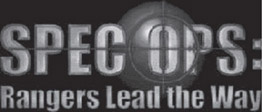
Good: Extraordinary visuals like fancy fireworks and light sourcing. Realistic team movements and terrain features, full mouse support, and the annoying timer was removed (time allotted to complete a mission).
Yosemite Entertainment’s Navy SEALs, PS2, and IBM PC
Navy SEALs is a squad-based action game where players select a team of highly trained commandos by recruiting each team member, equipping them, and setting their exact path for the mission. During the mission, the player controls one team member, and the computer (AI) controls the remaining team members. Navy SEALs has a unique helmet interface that lets the player switch between the team members that they control. To successfully complete a mission, understanding each team member’s special abilities (such as technical specialist, explosive expert, sniper, and weapons specialist) is required. Navy SEALs’ missions include invading a small island and infiltrating corporate buildings. Each mission has three squads of four team members each.
Good: Great graphics
Novalogic’s Delta Force
Delta Force had competition with Rainbow Six’s huge advertising budget and the household name recognition of Tom Clancy. Delta Force was well reviewed and hailed by fans but lost to Rainbow Six in sales.
![]()
Novalogic’s high quality demo available weeks before the game’s release had a devoted fan base awaiting its October arrival. Delta Force made PC Data’s Top 50 Games list.
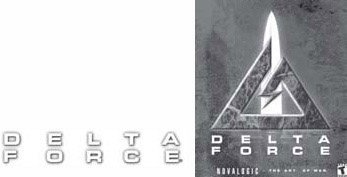
Free Internet support through NovaWorld Server with support for up to 32 players per game really helped Delta Force in its marketing and selling.
Delta Force has more than 40 exciting missions dealing with global issues like a Central Asian airfield takedown, nuclear terrorism in Northern Russia, and drug cartel raids in South America. Gameplay occurs in either first- or third-person POV with realistic sound effects using 3D positional sounds.
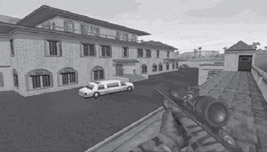
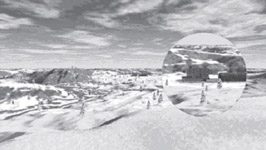
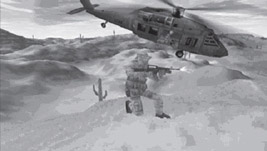
The weapons used in Delta Force are: Barret .50 “light fifty” model 82A1 is a long-range, high powered rifle perfect for snipers. M249 SAW (squad automatic weapon) is a hand-held, portable machine gun that can fire 200 rounds of 5.56mm ammo. M4 5.56mm carbine assault rifle is a lightweight and accurate, gas powered rifle used extensively for close quarter combat. M40A1 sniper rifle is a hand-made rifle based on the Remington 700 and made by gunsmiths at the rifle team equipment shop at Quantico, Va. for superior accuracy. Heckler & Koch 9mm MP5 SD submachine gun is a silent and accurate submachine gun capable of single-shot, burst, and automatic firing. Cot M 1911A1 .45 is a superior handgun that is handmade by gunsmiths at the rifle team equipment shop at Quantico, Va. High standard .22 pistol is a silent and super accurate handgun. M-72 LAW (light antitank weapon) launches a single 66mm explosive round that can penetrate a target with up to 350mm of armor. M18 claymore is an anti-personnel mine combining a sheet of C4 plastic explosive and 700 ball bearings inside a curved plate. An M57 remote firing device (called a “clacker”) has the exploding ball bearings propelled in 60-degree arcs traveling at a high speed up to 50 meters. Satchel charges are packed with high explosives for demolishing buildings and walls.
Good: Free Internet support
Bad: Lack of control over the computer controlled teammates and squads
Novalogic’s Delta Force 2
Delta Force 2 has over 40 day and night missions in weather conditions like snow, rain, and fog. The multiplayer mode has new games like Attack and Defend, Search and Destroy, and Flag Ball.

New weapons include a silenced Heckler & Koch .45 USSOCOM (United States Special Operations Command), the Heckler & Koch P11 (an underwater pistol), a Russian-made underwater rifle, time-delay grenades, a laser designator, and tracer rounds. A LAR V rebreather for extended underwater submersion is also available as well as a field-surveillance video camera.
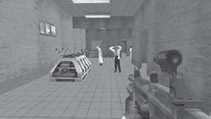
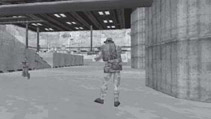
A lot of veteran fans requested a mid-mission site to change and fix weapons. So an “armory” building was created to allow players to change gear and fix machine guns and grenade launchers.
Weapons: Heckler & Koch 9mm MP5 SD 3 submachine gun, M249 SAW (squad automatic weapon), M-72 LAW (light antitank weapon), M40A1 sniper rifle, Barret .50 “light fifty” model 82A1. These five are the same as in Delta Force.
Other weapons: 5.66mm APS underwater assault rifle shoots penetrating 150mm long darts. The “master key” (a M4 combined with a shotgun) is a gas-operated rifle and an attached shotgun that can easily remove any door. Heckler & Koch P11 underwater pistol is a silent, electrically charged pistol. Heckler & Koch USSOCOM semiautomatic .45 pistol. M4 5.56 carbine assault rifle and M203 grenade launcher fires 40mm explosive ammunition. Fragmentation grenades will explode on impact or have a four- to seven-second time delay. Ka-Bar knife for silent, close-range attacks. LAR V rebreather for extended underwater submersion. Ghilke suit is a camouflage sniper suit. Kevlar vest is a body armor that protects against small arms fire.
Good: Delta Force 2 has smoother animations and more detailed graphics. The missions have a connecting storyline and new weapons are available. In single player, you can set waypoints and orders for your teammates and have the ability to revise those orders during the mission. Multiplayer has a new commander’s screen that allows easier attack coordination and lists needed multiplayer data like the player list, team list, and game settings (length of match, winning conditions, and mission briefing describing the goals and objectives).
Team member movements (animations) were added for swimming and climbing (ladders and sides of a building). Character “death” animations were made more realistic and varied. The enemy has a better AI algorithm using new, effective tactics.
An “in-game” save feature and a built-in mission editor were added. Better enhanced graphics supporting 32-bit color were added, making the terrain and weather effects (fog, rain, snow, and wind) realistic.
Realistic physics and ballistics (bullets penetrating various objects like a tent, a wall, or a concrete barrier) were implemented taking into account gravity, wind direction, and velocity. When a character fires, the shot is affected by gravity and wind. When a character falls or jumps, gravity determines the character’s injury or death.
NovaWorld server now supports up to 50 players and four teams, not just two. A “no-respawn” option forces dead players to leave the game.
Uniforms can be customized to give squads their own, unique look. Medals and awards are given to the best players.
Communicating with other players over a full-duplex sound card is handled entirely by the NovaWorld server (VON, or voice-over net technology).
Novalogic’s Delta Force Land Warrior
Delta Force Land Warrior has stunning and intense action. The ability to snipe someone from half a mile away while descending from a parachute is a great feature. In Delta Force Land Warrior, you are in control of an advanced strike team. Missions deal with terrorists and hostiles throughout the world. There are huge terrains to play on with tunnels and indoor scenarios.
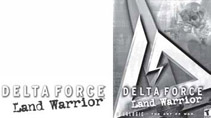
The multiplayer mode has capture the flag, king of the hill, and cooperative modes, and up to 50 players can play at a time. Players can choose their teams from sniper, demolition, close quarter battle specialists, aquatic experts, and heavy gunners.

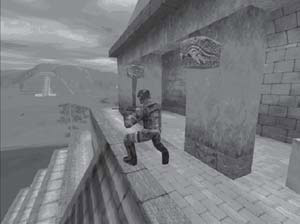
Weapon loadouts have increased from four (primary weapon, sidearm, grenades, and ammo or a LAW) to five (primary, secondary, sidearm, explosives, and auxiliary gear). The newest weapon of the future is the Alliant Techsystems’ OICW assault rifle. Additional weapons include the Steyr AUG light assault rifle, MM-1 grenade launcher, the Pancor jackhammer shotgun, the PSG-1, the FN mag light machine gun, the Heckler & Koch G11 assault rifle, Calico submachine gun, the Heckler & Koch .45 SOCOM, the Glock 18 submachine gun pistol, the AT-4 light anti-armor weapon, and a medic pack for multiplayer medics.
Another feature is picking up weapons from dead opponents. They use the same weapons to which you have access.
Good: Sharper, more detailed graphics
Basic System Requirements:
Video Card: Direct 3D compatible video card required. 3dfx Voodoo 3 or NVIDIA TNT2 recommended. Supported 3D cards include: 3DFX Voodoo 2, 3, 5, NVIDIA TNT, TNT2, GeForce, GeForce2, ATI Rage Fury Max, Matrox G400
Operating System: PC, CD-ROM, Windows 95, 98, Me, 2000 (DirectX 7.0 or greater)
CPU Type and Speed: Minimum Pentium II, Celeron 400, or equivalent required, Pentium II 400 MHz or equivalent recommended
Hard Drive Space: 200 MB available
System Memory: 64 MB required (with AGP video card: 128 MB recommended)
CD-ROM Speed: 4x CD-ROM drive
DirectX: DirectX 7.0 or greater required (included on CD)
Sound Cards: Windows compatible. Voice-over net (VON) requires full duplex sound card
Supported Controllers: Windows compatible mouse
Internet Play: Up to 50 simultaneous players via NovaWorld servers (Internet service provider required)
LAN Play: IPX LAN Support
Novalogic’s Delta Force: Task Force Dagger
Delta Force: Task Force Dagger is based on missions from Operation Enduring Freedom where the player controls up to ten different Special Forces soldiers in over 25 missions set in Afghanistan. Each team represents members of the 2/75th Ranger, SEAL Team 6, CIA Spec Ops, the UK SAS 22 Regiment, SFOD-SF Viper Team (Green Berets), Australian SASR, Canadian JTF-2, Marine Force Recon, USAF CSAR (Air Force Pararescue), and SFOD-DELTA.
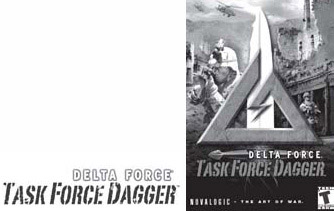
Missions range from Kandahar to Mazar-i-Sharif to Tora Bora, each in deep enemy territories. Delta Force operatives’ missions include raids on rebel headquarters, taking control of a local airport, ambushing enemy convoys, and destroying key SAM and SCUD missile sites.
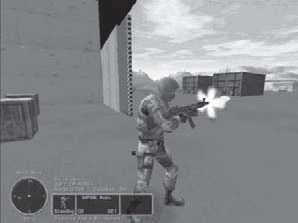
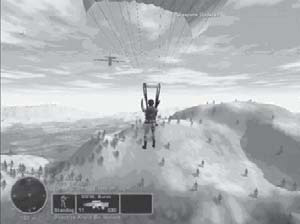
Delta Force: Task Force Dagger uses NovaLogic’s updated Land Warrior engine and is designed as a stand-alone mission pack with new characters, weapons, and single and multiplayer levels.
Delta Force: Task Force Dagger includes 25 all new missions designed to test the team’s reactions and bravery while operating under fire. This version is the first Delta Force game where the player represents different Special Forces soldiers with unique abilities and has over 30 weapons to select from, including 17 brand new weapons. Each mission is realistic and includes a strategic recon and objective, such as locate and neutralize, infiltrate and secure, and escort and protect civilians. UAVs (unmanned aerial vehicles) can be used for spying and calling in devastating air strikes. Missions include a takeover of the Kandahar airport, a raid of rebel headquarters in Mazar-i-Sharif, an ambush to a convoy near the Pakistani border, the elimination of a command and control compound in Kandahar, the demolition of bunkers in the foothills of Kabul, destroying a SAM site, escorting a journalist through hostile territory, and raiding the Abu Khabab chemical weapons facility.
The 17 new weapons in Delta Force include primary and secondary weapons, sidearm weapons, grenades, and explosives. The primary weapons are the Diemaco C8 carbine with ELCAN scope, M16A2 with M203, M4 SOPMOD with ACOG scope and Knight Rail accessory system, SA80 individual weapon, M60 assault rifle, M60E3 assault rifle, M24 sniper rifle, M40A3 sniper rifle, and AW sniper rifle. M4 SOPMOD has a telescopic butt-stock with ACOG scope and KRAS, which is a 5.56mm assault weapon produced for the U.S. Army, and Knight Rail accessory system. The AW sniper rifle is a 7.62mm sniper rifle, a second-generation sniper rifle developed for Artic warfare functioning in temperatures below –30.
The secondary weapon includes the F89 Austeyr. The sidearm weapons are the Browning HP, Sig P226, FN Fortynine, and F97 (Glock 19). The Browning HP is a 9mm side arm that was designed in 1935 by John M. Browning. The Browning HP is in active service all over the world.
The grenades include the US Mk3A2 concussion grenade, and the explosives include the Alliant SLAM (selectable lightweight attack munition) and the M72 LAW (light anti-tank weapon). Mk3A2 concussion grenade is an offensive hand grenade, commonly referred to as the concussion grenade, designed to produce casualties.
The tactics include scenarios like spying on the enemy and calling in air strikes, controlling the cameras on unmanned aerial vehicles to gather visual intelligence and plan your attack with the element of surprise, and calling in devastating air strikes to take out key SAM and SCUD missile sites.
Multiplayer mode NovaWorld or LANs have ten new multiplayer maps, deathmatch, capture-the-flag, and co-op modes. Players can create infinite game types and maps with the mission editor.
Novalogic’s Delta Force Urban Warfare
The Delta Force franchise set the standard in first-person military action shooters when it was released and has a customer base of 2.6 million PC gamers globally. Now Delta Force Urban Warfare is designed for the PlayStation game console in an all-new Delta Force experience by Rebellion.
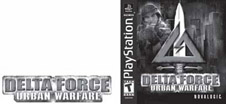
Diverse, intense gameplay includes wild shoot-outs combined with stealth tactics, close quarters combat (CQC) with strategic infiltration, time-sensitive ops, sniping, and demolition. An advanced enemy AI lets players engage and defeat enemies that react to gunfire, dive for cover, employ tactical maneuvers, and pursue using a player’s blood trail.
The new firepower and hi-tech gear includes assault and sniper rifles, grenade and rocket launchers, plus remote explosives, night vision and thermal goggles, combat radar, and a security camera scrambler.
There are 12 challenging missions, such as intercept communications, capture prisoners, and conceal enemy bodies. Blast your way out of a bank robbery, rescue and protect hostages, defuse explosives, and attack an oilrig.
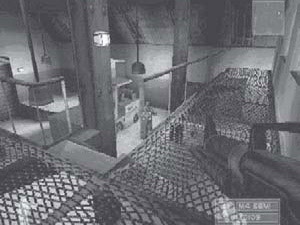
Urban Warfare has an intriguing storyline (presented in cut-scenes and in-game radio messages) that propels you through each mission.
Novalogic’s Delta Force: Black Hawk Down
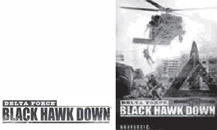
NovaLogic’s Delta Force: Black Hawk Down is set in Somalia in 1993 and based on the real-life events of Operation Restore Hope and Task Force Ranger campaigns by the U.S. Army and Delta Force against the oppressive Somali warlords in and around Mogadishu. The latest NovaLogic game engine is utilized for the PC CD-ROM version and the Xbox and PlayStation 2 versions. The gameplay includes missions such as firing from vehicle mounted weapons, including the .50-caliber fixed machine gun, close quarters battle engagements and Delta Force’s signature long-range engagements, authentic weapons used during the actual Operation Restore Hope campaign by the U.S. Special Forces, a new AI system allowing enemies to intelligently track the player, large-scale multiplayer action via NovaWorld or a LAN, stunning graphics, and a realistic, gripping storyline.
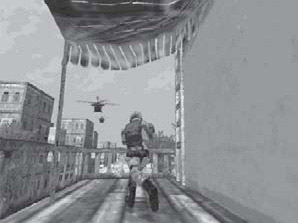
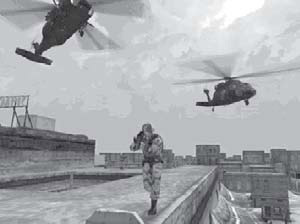
Red Storm’s Rainbow Six
Rainbow Six is from legendary author Tom Clancy and has the player leading an elite multinational task force to battle international terrorism in a series of realistic missions and mission training sessions. Rainbow Six is designed in two parts: mission planning and mission execution (action).

The training mission is comprised of various shooting ranges, obstacle courses, and single-team and multiteam hostage rescues. The main campaign has various multiplayer modes, such as cooperative mission, deathmatch, and team deathmatch.
There are three levels of difficulty for the campaigns where each level has more objectives and less team casualty tolerance. To advance to the next mission, you must successfully complete the previous mission. If you accidentally kill a civilian or yourself (even if you injure yourself), the mission must be repeated. Even one bullet can injure or kill you, so wearing body armor will protect the team and perhaps make a mission successful.
Rainbow Six can be played in first- or third-person POV. The team is selected before each mission from 20 possible characters. The first mission plan is provided, and the remaining missions are up to the player to plan. Each mission requires the mission’s plot objectives (such as rescuing hostages, stealing vital information, disarming a bomb, or covert actions) to be successful.
Players can switch between teams but not team members, and waypoints can be set for team members to follow.
Weapons: Benelli M1 tactical 12-guage, M-16A2, Beretta 9mm 92FS, Heckler & Koch .40 USP, Heckler & Koch .45 MARK 23, flashbangs, explosive flares, grenades, door charges, disarm bomb kit, disable alarm systems kit, heartbeat sensor
Good: Simple Quake-like interface with an immersive, realistic feel. Better graphics, especially in human motion and movement and lighting. Realistic audio, background sounds, character voices, and special effect noises (realistic gun sounds). Solid storyline and a good manual.
Bad: Poor AI when engaging enemies, especially in CQB situations (patch available). Teammates will wait for the next waypoint “go code” instead of moving. Grenade explosion zone is too limited. It’s around two feet from explosion point. A lot of time is spent defining and redefining the mission layout (average mission planning takes 20 to 40 minutes). Multiplayer deathmatches can be one shot and you’re out (dead). Single-player missions are short and easy to solve.
Red Storm’s Rogue Spear
Terrorist activities require the Rainbow Six team’s special abilities. Initially, the terrorist attacks seem random, but the team soon uncovers the truth behind this cleverly planned strike.
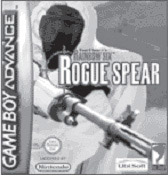
Rogue Spear has 18 missions, such as (fourth mission) hostage rescuing in Djakovica, Kosovo, where a NATO helicopter has been shot down and the pilot and passenger need to be rescued. In the sixth mission, the team must enter an enemy base, disable the security system, plant a phone bug and a surveillance camera in a key area, and leave unnoticed.
After a mission is successfully completed, two new modes are available: lone wolf and terrorist hunt. In lone wolf the player traverses the map alone with thirty randomly played enemies on alert. In terrorist hunt the player wanders the map and must kill all enemy characters.
Rogue Spear still has the practice mission and branch campaign options as in Rainbow Six. There are new orders that can be given, which are cover, defend, and snipe.
Rogue Spear has weather conditions like snow and rain. The characters can now crouch, limp, die in realistic manners, and peek around corners. Rogue Spear has three new sniper rifles and new assault rifles.
The “watch mode” allows players to see the mission as it is carried out and enter it at any point.
Good: Better graphics with greater levels of detail, larger mission terrain, and better character animations. Highly decorated buildings with nice-looking interiors including randomly wandering civilians. The textured planning map looks great. Graphics support now includes 1024x768 resolution. The snipers are much better to control. Multiplayer has great options like the ability to play Rogue Spear on Mplayer and MSN Gaming Zone. Also, the assassination mode in multiplayer (to defend an NPC, a building, or a base) is great.
Bad: Graphics have polygonal clipping problems. First- to third-person switching has misaligned texture and clipping problems. The AI was fine-tuned (enemies now act more realistic) but perhaps too much since enemies rarely miss. Computer-controlled team members move and react worse than in Rainbow Six. Team members still get stuck in doorways, stuck on ladders, and fall off elevated walkways. The new planning interface is cluttered and hard to understand. The team members still can’t jump, crawl, or swim, which would make the game better.
The first three missions are rather boring to play.
Rogue Spear: Black Thorn
Team Rainbow has a new deadly enemy that knows how Rainbow thinks, how Rainbow acts, and how to stay one step ahead.
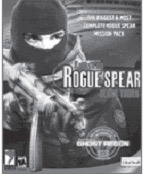
Black Thorn features new multiplayer mode (lone wolf), up to 16 players in multiplayer mode, six new training/multiplayer maps, more than ten new weapons for single and multiplayer modes, and a bonus CD (The Making of Tom Clancy’s Ghost Recon) containing developer interviews, gameplay video, hints and tips, weapon previews, and more.
Minimum system requirements include a CPU with 266 MHz Pentium II processor or better, an operating system with Windows 95/98/2000, 64 MB RAM (128 MB recommended), a video card with DirectX 8 or higher, compatible 2D video card capable of 16-bit color, 3D hardware support with DirectX 8 compatible video card with 4 MB VRAM (DirectX 8 compatible 3D accelerator with 16 MB VRAM recommended), CD-ROM with 4X or better, sound with DirectX 8 or higher compatible sound card required, and 550 MB free hard drive space required (1 GB recommended).
Rogue Spear: Urban Operations
A barrage of cold-blooded, grenade-throwing terrorists challenge your skills and training. The game features famous cities in real-world locations, five fantastic new levels with four game types for each, more than five new multiplayer levels playable as single-player terrorist hunt or lone wolf, five classic levels from the original Tom Clancy’s Rainbow Six, and terrorists with new skills.

Red Storm’s Ghost Recon
Ghost Recon was IGN’s Game of the Year. Ghost Recon has missions in forest terrain, murky swamps, and urban combat terrain. Players can choose six teammates, not just three, to be distributed among the three mission squads. The mission’s possible team can be chosen from six rifleman, two support specialists, two snipers, and two demolition experts. A new device called a “threat indicator” alerts you to the enemy’s location.
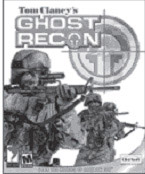
Good: Great graphics with superb trees and shrubbery. Better AI for the enemy and team members. Enemy AI fire will display tracers. The enemy will cover, flank, and go prone. Teammate AI is improved, especially in backing you up. The in-game planning interface has improved and represents the future implementation of the U.S. Military’s land warrior system.
Ghost Recon: Desert Siege
Red Storm’s Ghost Recon continues with Desert Siege, which takes place in East Africa, 2009. A 60-year conflict boils over as Ethiopia invades its smaller neighbor Eritrea, threatening the world’s most vital shipping lanes in the Red Sea. An elite team of U.S. Army Green Berets, known as the Ghosts, moves in to safeguard the seas and free Eritrea. As the war rages on, the Ghosts are drawn from Eritrea’s shores to the heart of Ethiopia in their deadliest battles yet.
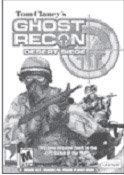
Rainbow Six: Eagle Watch
Rainbow Six: Eagle Watch is an expansion pack that requires the full version of Rainbow Six to operate. This time terrorists threaten the world’s most famous sites such as the Taj Mahal, Big Ben, the Forbidden City, the Senate wing of the U.S. Capitol Building, and a classified Russian shuttle.

The new multiplayer modes (two to eight players) include assassin, scatter assassination, scatter, team terrorist hunt, team scatter terrorist hunt, and save the base.
Assassin mode is when teams at one insertion point kill the other team’s general. Scatter assassination mode is when teams are at scattered positions from the start and must kill the other team’s general. Scatter mode is when the team’s individuals are placed initially at scattered positions. Team terrorist hunt mode is when teams start at one base and attempt to kill terrorists. The team that kills at least half of the terrorists first wins. Team scatter terrorist hunt mode is when teams starting at scattered positions attempt to kill terrorists. The team that kills at least half of the terrorists first wins. Save the base mode is when each team attempts to defuse a bomb located in the other team’s base.
The new weapons include the Desert Eagle .50-caliber (a very powerful handgun capable of piercing body armor with its six-round magazine), Heckler & Koch G36K assault rifle (a compact rifle useful in CQB with a 5.56mm round capable of piercing most body armor), and the Heckler & Koch G3A3 assault rifle (most accurate rifle firing a powerful 7.62mm NATO round).
There are also four new operatives added to the Rainbow Six team.
Rainbow Six: Eagle Watch is available for the PC, Macintosh, PlayStation 2, and N64.
Good: Beautiful graphics of the world’s most famous sites. Full watch option where players perform the planning and let the computer execute it as they watch each step executed, which turns Eagle Watch into a strategy game. The new multiplayer modes are well done, especially the new training modes and maps. The available options are a great feature. This expansion pack is worth the cost and is better than some of the new top sellers.
Bad: Using the “default plans” for each mission, the experienced player can finish Eagle Watch (all five missions) quickly. The new weapons add nothing to the gameplay. The four new operatives are not significant. The manual is still Red Storm’s worst feature. The enemy AI is still lacking, especially when they idle in place and stand around looking as if they are unaware that an attack is about to occur.
Rainbow Six: Covert Operations Essentials (aka Covert Ops)
Rainbow Six: Covert Ops gives the player an insight into the real world of counter-terrorism from 1970 to today. The first of two CDs is a stand-alone (no previous version of Rainbow Six or Rogue Spear is needed to play) mission pack containing nine new missions ranging from a simple covert training mission to a complex jungle search and rescue mission through enemy terrain. The second CD contains a complete Rainbow Six team kit including real-life documentation and tactical training based on the most accurate real-world sources. The player, using these actual military documents, executive-level briefings, and interviews with field experts, advances through a series of tests where success earns the player achievement ribbons for the character. A wide selection of interactive tests are provided from simple document-based questions to complex photo and video-based questions.
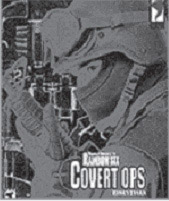
Red Storm’s Rainbow Six: Raven Shield
The latest addition to the Rainbow Six action-packed, realistic series is Rainbow Six: Raven Shield in which the Rainbow Six team, as told by legendary author Tom Clancy, is commissioned to utilize its advanced technology throughout the world. The latest Unreal engine is being used in this 15-mission, single-player mode that has the gameplay in first-player perspective. The Unreal Warfare engine gives Raven Shield detailed textures, realistic animations, real-time lighting effects, and shadows. The Unreal Warfare engine has features such as skeletal meshes that allow for movement through the program and now through scripting or canned animations. The sound effects in Raven Shield are very realistic, and the ambience is heard throughout the player’s environment.
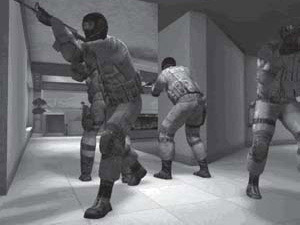
The next change from previous versions is in the planning screens or pregame menu system, which is now much easier to understand and faster to manipulate (the same options are still available, just easier and more user-friendly). A quick order interface allows for real-time insertion of orders. From a single screen, a team can be selected, put in uniform, and sent out on a mission. The old way of planning the operation in a detailed method is still available. Raven Shield allows each weapon to be modified with one additional attachment, such as a sound suppressor, thermal sniper scope, high-capacity magazine, or a mini-scope. Even if a weapon has a built-in attachment such as the MP5SD5, which comes with a sound suppressor, it can have an attachment added to it. Think of the combinations of adding one of four attachments to the 57 weapons included in Raven Shield, and you have a lot of high-tech weaponry that matches real-world available weapons.
Some of the new weapons in Raven Shield are the MTAR-21 9mm submachine gun, the Mac-11/9 9mm submachine gun, the Micro-Uzi 9mm submachine gun, the SR-2 9mm submachine gun, the USAS-12 12-gauge shotgun, the TAR-21 5.56mm assault rifle, the Type 95 5.56mm assault rifle, the VSS Vintorez 9x39mm sniper rifle, and the 23E 5.56mm machine gun. Also at your disposal are claymore mines, tear gas grenades, gas masks, smoke grenades, and frag impact grenades.
|
|
EAN: 2147483647
Pages: 179